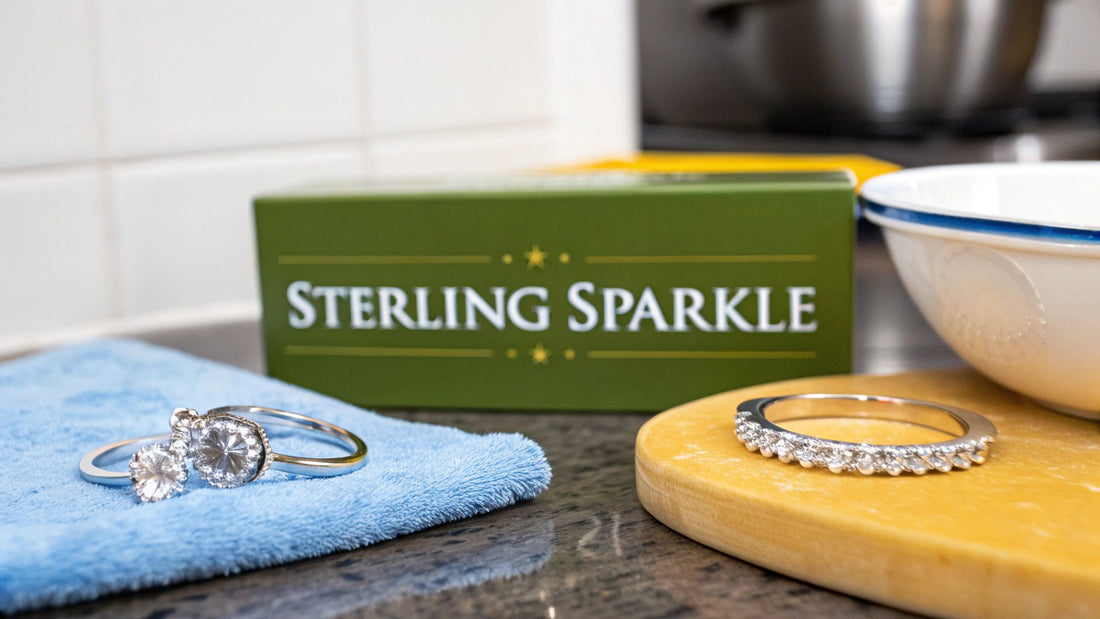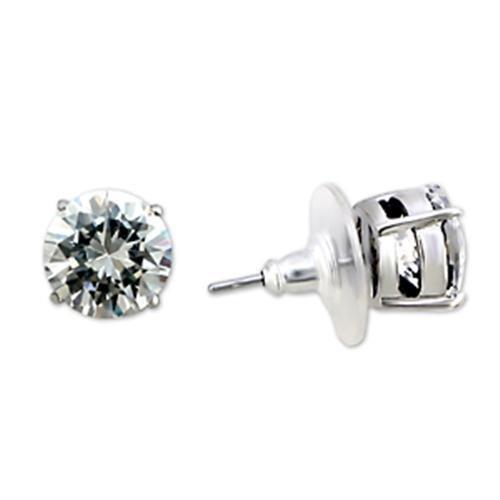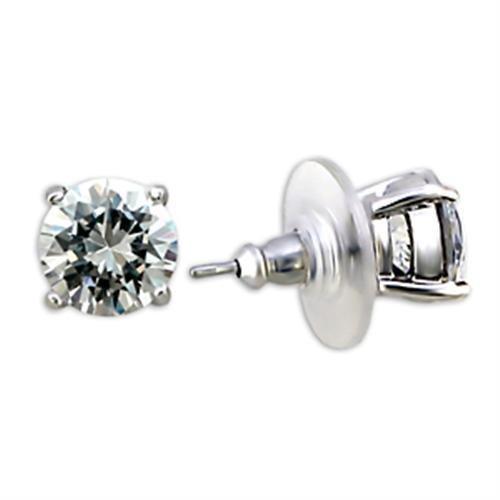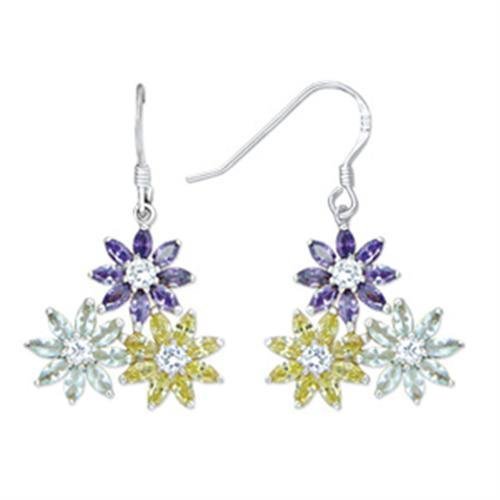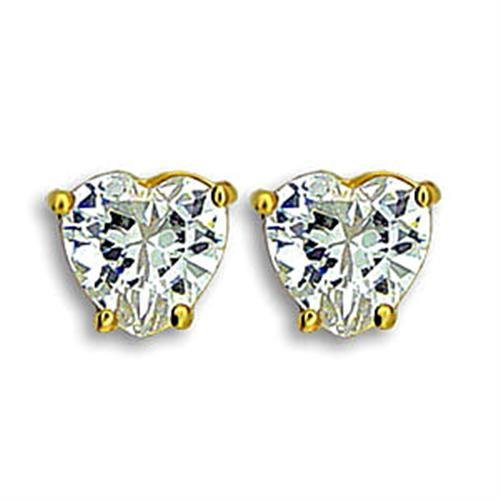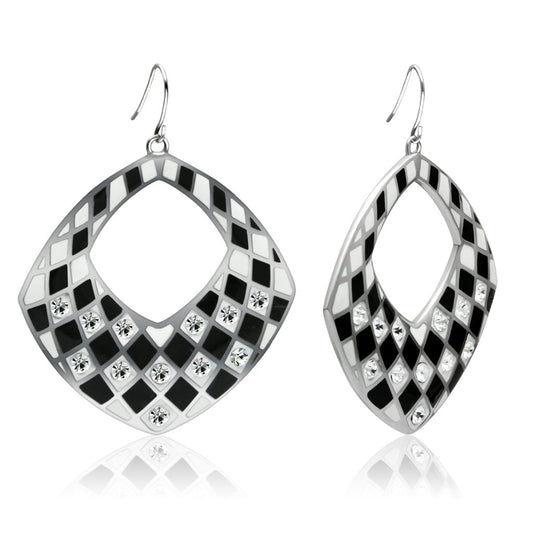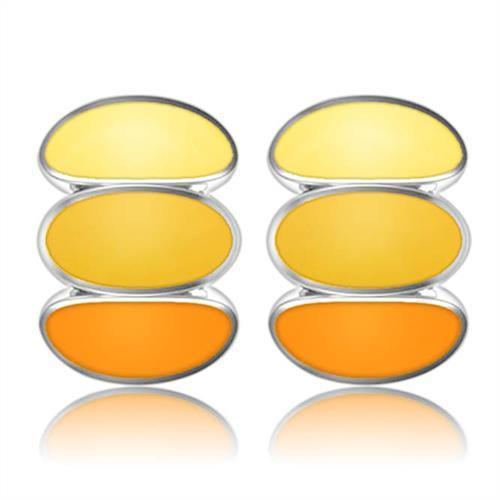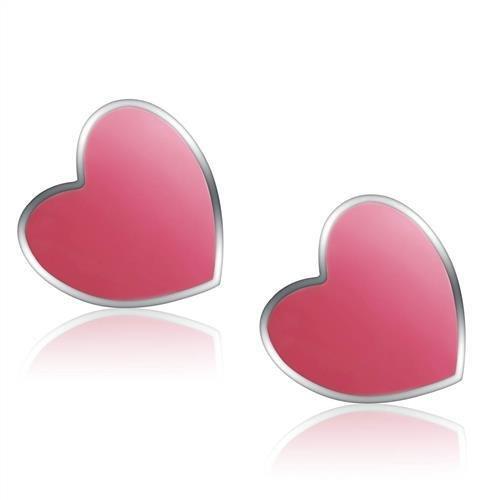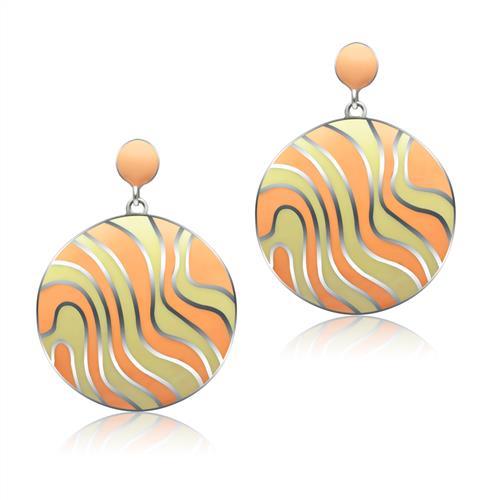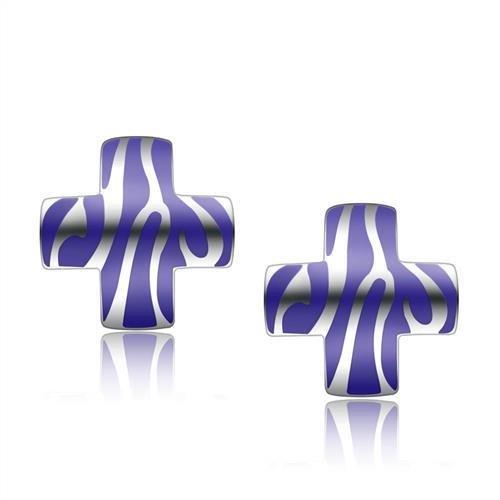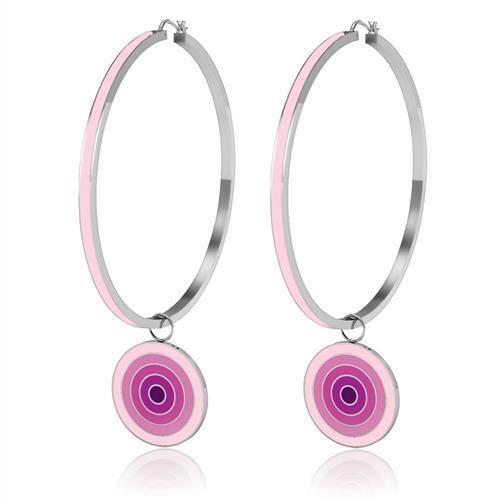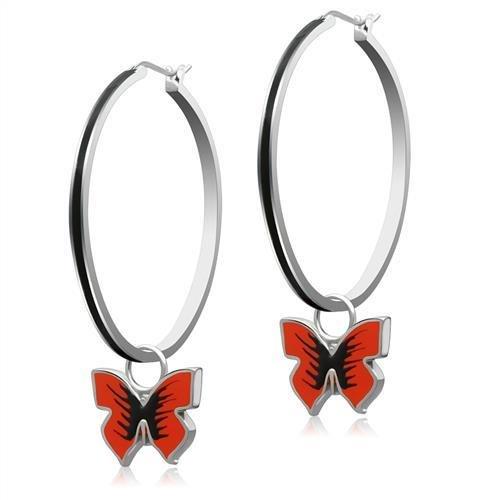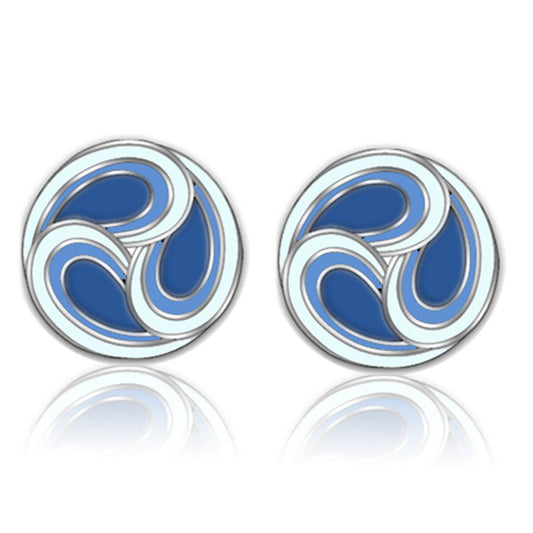It’s a story every jewelry lover knows all too well: that once-brilliant sterling silver piece now looks dull, dark, and a little sad. But here's the secret: restoring its shine is far simpler than you might imagine. You can easily learn how to clean sterling silver jewelry using gentle, at-home methods that turn back the clock on tarnish and bring back that incredible sparkle.
Why Your Sterling Silver Loses Its Sparkle
That darkening on your favorite necklace or ring isn't a flaw in the metal—it's just a completely natural chemical reaction. Sterling silver is 92.5% pure silver mixed with other metals (like copper) to make it strong enough for daily wear. When it’s exposed to sulfur compounds in the air, a reaction occurs, creating silver sulfide.
That blackish layer is what we call tarnish.
The great news? Tarnish only sits on the surface. It's entirely reversible, and you definitely don’t need to rush off to a professional jeweler for every little bit of discoloration.
What’s Causing The Tarnish?
Several everyday factors can put the tarnishing process into overdrive. Once you know what they are, you can take steps to prevent it.
The main culprits are usually:
- Humidity and Air Exposure: Moisture in the air is tarnish’s best friend. Leaving your jewelry out on a dresser or in a steamy bathroom is a surefire way to speed up discoloration.
- Contact with Chemicals: Think about the products you use daily. Lotions, perfumes, hairspray, and even household cleaners contain substances that react with silver.
- Your Own Body Chemistry: The natural oils in your skin can sometimes cause a reaction, though for many people, these same oils actually help keep their silver polished. It really just depends on your unique chemistry.
The most important thing to remember is that tarnish doesn't actually harm the metal underneath. With the right touch, you can safely remove it and bring your jewelry back to its original brilliant self without causing any damage.
Choosing the Right Cleaning Method
Not all tarnish is created equal, so your cleaning approach shouldn't be one-size-fits-all. For pieces that are just a little dull, a simple wash is often all you need. On the other hand, more stubborn tarnish requires a bit more effort.
To make it easier, here's a quick rundown of some gentle DIY methods.
Choosing Your DIY Cleaning Method
This table compares a few gentle, at-home cleaning methods to help you decide which is best for your jewelry based on how tarnished it is.
| Method | Best For | Tarnish Level | Key Ingredient |
|---|---|---|---|
| Simple Soap & Water | Routine cleaning, new jewelry, very light dullness | Light | Mild Dish Soap |
| Baking Soda Paste | Textured or detailed pieces with moderate tarnish | Medium | Baking Soda |
| Warm Water & Foil Soak | Heavily tarnished items (without stones) | Heavy | Baking Soda & Salt |
| Polishing Cloth | Smooth surfaces, quick touch-ups before wearing | Light to Medium | Micro-Abrasives |
Always start with the mildest method first. You can always move on to something stronger if needed, but you can't undo damage from a harsh chemical or abrasive.
This guide will walk you through everything, starting with the gentlest techniques and moving toward solutions for more stubborn cases. We’ll show you which common household items are your secret weapons and, just as importantly, which popular "hacks" you should avoid at all costs. You can learn more about these gentle yet effective techniques for your sterling silver.
Gentle Cleaning for Light Tarnish and Routine Care
When your favorite sterling silver pieces start looking just a little bit dull or have lost some of their initial pop, you don’t need to break out the heavy-duty chemicals. The most effective approach for routine upkeep and light discoloration is also the simplest and safest one. Think of it as preventative care—the kind that preserves your jewelry’s beautiful finish for years to come.
This "less is more" philosophy starts with a simple soap and water bath. It's the perfect first step for any piece of sterling silver, especially for regular maintenance after you've worn it. Consistent, gentle care will always beat infrequent, aggressive cleaning sessions.
The Ideal Soap and Water Bath
The magic here is really in the details. Your goal is to mix up a solution that gently lifts away skin oils and light grime without being harsh.
First, grab the right soap. A few drops of a mild, phosphate-free dish soap are all you need. You'll want to avoid any harsh detergents or soaps with unknown additives, as they could unexpectedly react with the silver.
Next, pay attention to the water. Always use lukewarm water, never hot. Boiling water can be a shock to the metal and could even damage delicate pieces or loosen the settings of any gemstones you might have. Just mix the soap into the warm water until you have a slightly sudsy bath.
Expert Tip: Drying your jewelry properly is just as important as washing it. After cleaning, take a soft, lint-free cloth—a microfiber or jeweler's cloth works perfectly—and gently pat each piece dry. This simple step prevents water spots from forming, which can leave a dull film on the surface and undo all your hard work.
Mastering the Silver Polishing Cloth
For quick touch-ups and daily maintenance, a high-quality silver polishing cloth is an absolute game-changer. These cloths have become a standard recommendation from jewelers everywhere, and for good reason. They are specially treated with non-toxic chemical cleaners that gently whisk away tarnish without scratching the metal or harming any gemstones.
Since silver can tarnish surprisingly fast—sometimes within just a few days of being exposed to the air—these cloths are perfect for frequent, light cleaning. You can read more about how experts suggest keeping silver shiny on HarpersBazaar.com.au.
The technique you use here really matters. To avoid creating fine, circular scratches, always polish with long, straight, back-and-forth motions. If you can, follow the grain of the silver. It's a professional trick that ensures you lift the tarnish evenly while buffing the surface to a brilliant shine.
This method is especially great for pieces with smooth surfaces, like pendants or the bands of rings. By working these simple habits into your routine, you can easily maintain the brilliant luster of your favorite sterling silver. A gentle bath followed by a proper polish is often all it takes to keep your accessories looking like new.
A Chemical-Free Solution for Stubborn Tarnish
When a simple polishing cloth just won’t cut it for heavy tarnish, you might think your only choice is an aggressive, store-bought paste. But there's a much safer—and surprisingly effective—solution using a few common household items. This method is a total game-changer for restoring heavily discolored pieces without causing damage.
The science behind it is both simple and elegant. Instead of abrasively scrubbing away the tarnish (which is technically silver sulfide), this process chemically converts it back into pure silver. This means you restore that brilliant shine without stripping away any of the precious metal—a common and unfortunate side effect of harsh polishes.
It’s a fantastic way to clean sterling silver, especially those intricate pieces where tarnish loves to hide.
Preparing Your Silver Cleaning Bath
To get started, you'll need a few things: a small bowl, aluminum foil, baking soda, and some hot water. The real key here is making sure your jewelry makes direct contact with the foil while it's submerged in the solution.
First, line your bowl with a sheet of aluminum foil, shiny side up. Lay your sterling silver pieces right on top of the foil. It’s best to spread them out so each item is touching the aluminum, as this contact is what makes the whole reaction happen.
Next, you'll mix up the cleaning solution. The infographic below gives you the simple, precise steps.
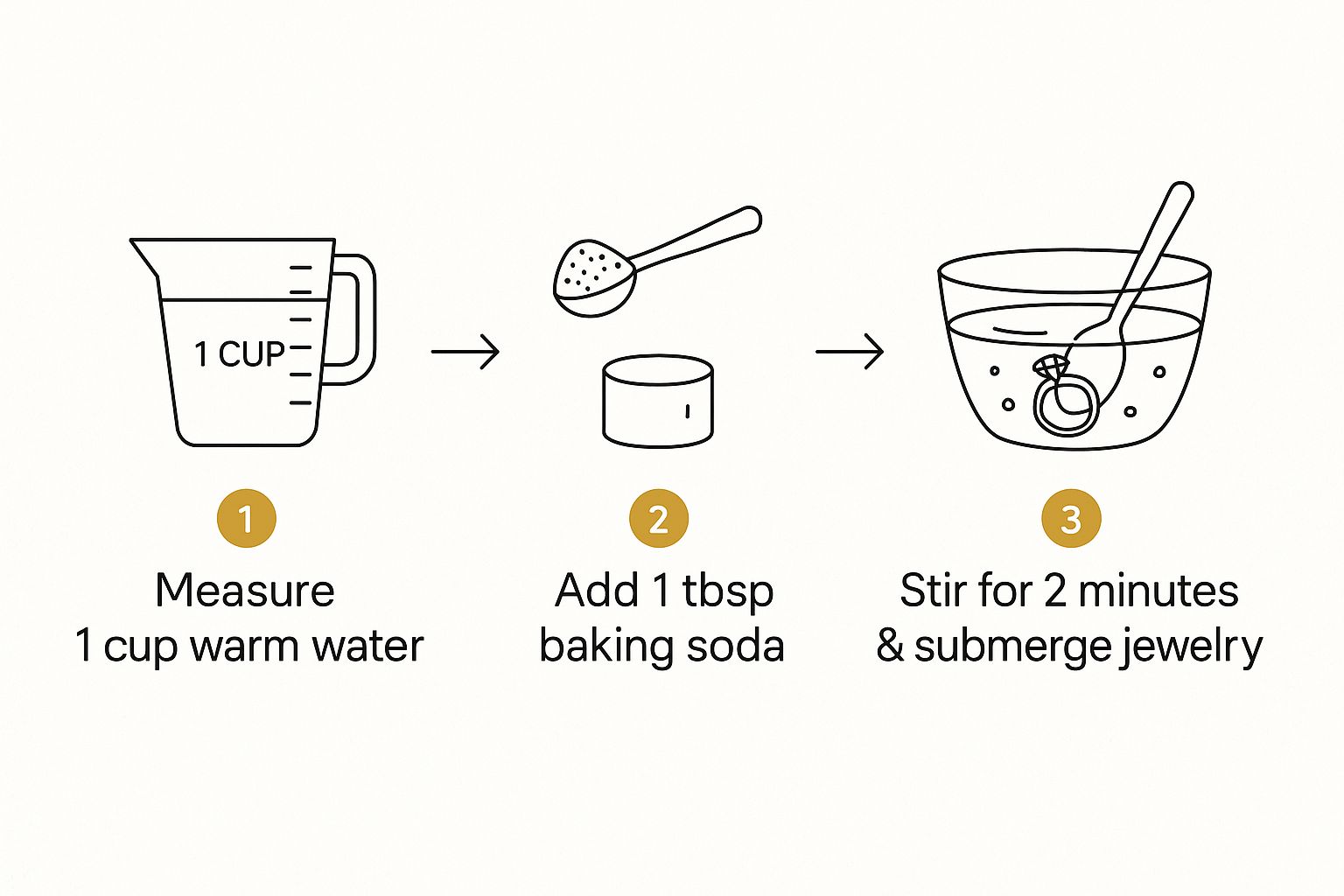
This visual guide takes all the guesswork out of creating the perfect cleaning bath. It's a straightforward method that gives you the confidence to clean your jewelry right at home.
The Gentle Cleaning Reaction
Once you pour in the hot water, the magic begins. You'll see little bubbles form as the baking soda reacts with the aluminum foil and the silver sulfide on your jewelry. This process essentially transfers the sulfur atoms from the silver to the aluminum, lifting the tarnish right off.
Let your jewelry soak for about two to five minutes. For really stubborn tarnish, you might need a bit longer, but you’ll often see a dramatic improvement almost instantly.
This technique is actually a modern spin on a method that’s been trusted for decades. It uses a clever electrochemical process with basic items you already have. Unlike harsher solutions that use acids, this reaction is non-corrosive and preserves your jewelry's integrity, making it a safe choice even for frequent cleaning. You can read more about the history of this silver cleaning secret on CleanMySpace.com.
After the soak, carefully take the jewelry out—be warned, it will be hot! Rinse each piece under cool running water to wash away any leftover residue. Finally, gently pat it dry with a soft, lint-free cloth and buff it to a brilliant shine. You’ll be amazed at how this simple, chemical-free bath can bring even the most tarnished pieces back to life.
Using Commercial Silver Cleaners Safely
While our DIY tricks are perfect for everyday upkeep, there are times when a piece is so tarnished it needs a little extra muscle. When you’re faced with stubborn, deep discoloration, a commercial silver cleaner can feel like a miracle worker, cutting through grime and restoring shine in minutes. These products are formulated specifically to handle heavy tarnish without harming the metal itself.
But here’s the thing: not all cleaners are made equal. You’ll find everything from chemical dips and foams to polishing creams on the market. Your number one rule should always be to pick a product that is explicitly labeled for use on sterling silver. A general-purpose metal polish might seem like a good idea, but it can contain harsh abrasives or chemicals far too aggressive for your delicate jewelry.
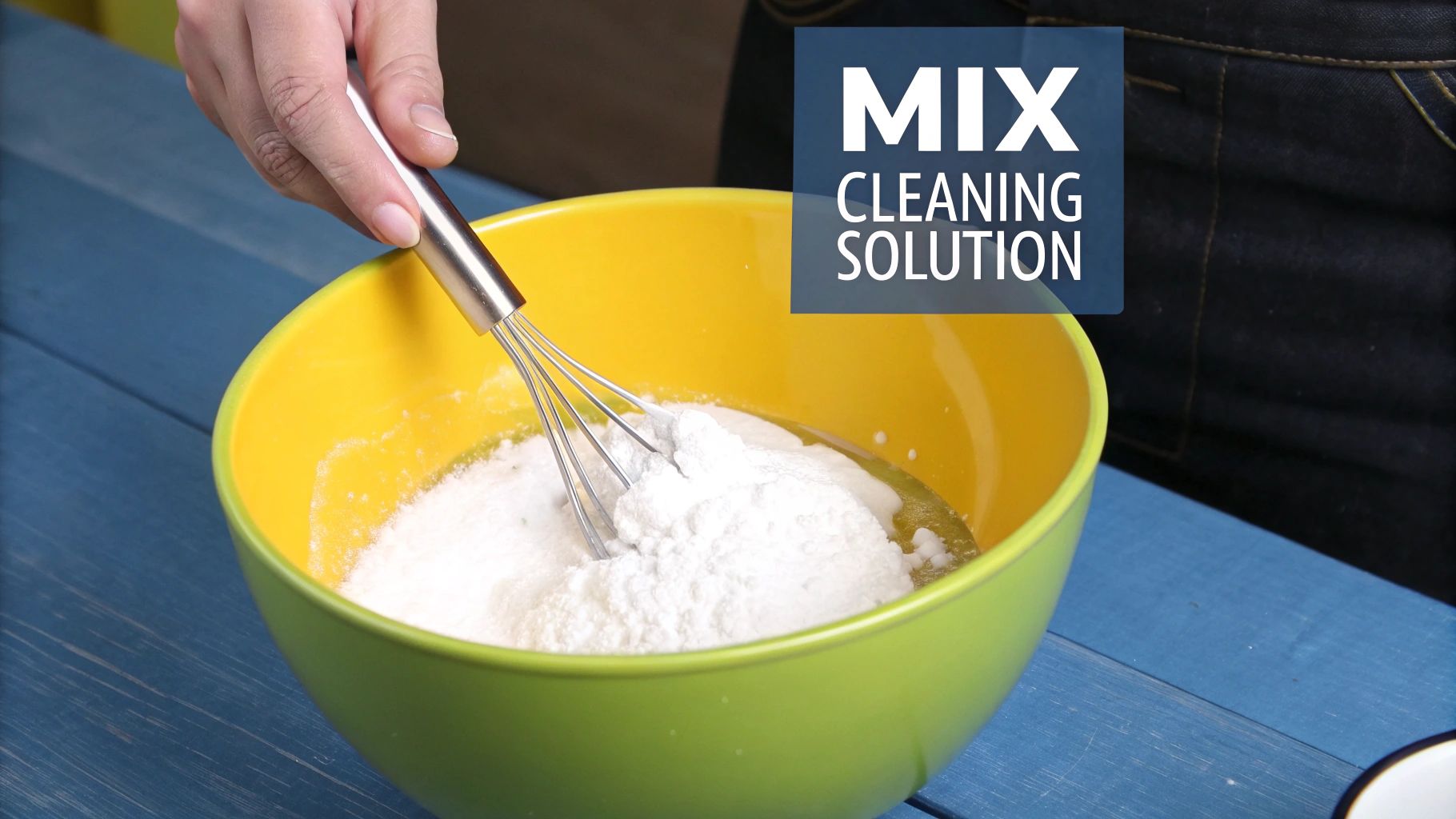
Applying the Cleaner Correctly
The secret to using these powerful solutions without causing damage is all in the application. Always, always start by reading the product’s instructions. Timings can vary wildly between brands, and one of the most common mistakes is leaving jewelry in a chemical dip for too long. Do that, and you risk stripping the finish or even etching the silver.
Here are a few essential tips for safe and effective use:
- Ventilate Your Space: These cleaners can have some pretty strong odors. Open a window or turn on a fan before you start.
- Glove Up: Protect your skin. A simple pair of rubber or nitrile gloves will keep the chemicals off your hands.
- Rinse Like You Mean It: This is the most crucial step. Once the tarnish is gone, rinse your jewelry under cool, running water to stop the chemical reaction and wash away any residue.
- Dry Completely: Pat the piece dry with a soft, lint-free cloth. Any lingering moisture can quickly lead to new water spots or tarnish.
Important Takeaway: Think of commercial cleaners as a targeted treatment, not a casual bath. Sticking to the recommended time—often just a few seconds to a minute—is non-negotiable if you want to avoid over-processing the silver.
When to Seek a Professional Jeweler
Some pieces are simply too precious or delicate for at-home cleaning, whether you're using a DIY method or a store-bought product. Knowing when to step back and let an expert handle it can save you from an expensive—or heartbreaking—mistake.
You should always consult a professional jeweler in these situations:
- Porous or Soft Gemstones: Never, ever use chemical dips on jewelry set with pearls, opals, turquoise, coral, or emeralds. These stones are porous and can be permanently ruined by harsh chemicals.
- Valuable Antiques: An antique piece often has a delicate patina that adds to its character and value. A professional knows how to preserve this while safely removing harmful tarnish.
- Intricate Filigree or Set-in Designs: If a piece has complex details or delicate stone settings, a jeweler can clean it thoroughly without loosening stones or damaging the intricate metalwork.
Reputable jewelers, like the experts at a trusted shop such as Fink's Jewelers, have specialized equipment to inspect settings and restore your piece safely. Knowing when to call in a pro is just as important as knowing how to clean it yourself.
How to Prevent Tarnish and Keep Your Silver Shiny
Once you've brought your favorite sterling silver pieces back to their original glory, the real work begins: keeping them that way. Let's be honest, preventing tarnish is far less effort than scrubbing it away. By making a few small, smart habits part of your daily routine, you can dramatically cut down on cleaning time.
It all starts with knowing your enemy. Tarnish isn’t dirt; it’s a chemical reaction. The main culprits are floating all around us—humidity, air pollutants, and chemicals lurking in our favorite lotions and perfumes. When silver meets sulfur in the air, that dull, dark layer begins to form. Add a little moisture, like the steam from your shower, and you’ve just supercharged the process.
Adopt Proactive Daily Habits
Little changes in how you wear and care for your jewelry can make a world of difference. Think of these simple adjustments as your first line of defense against discoloration.
One of the most powerful habits you can adopt is making your jewelry the last thing you put on and the first thing you take off. Always apply your lotions, perfumes, makeup, and hairspray first. Let them dry completely before you even think about putting on your silver necklace or rings. The chemicals in these products can speed up tarnishing and coat your beautiful pieces in a dull film.
Here’s a tip that might surprise you: wear your silver often! The natural oils on your skin can actually help polish your jewelry, keeping it clean and bright just by going about your day. While everyone’s skin chemistry is a bit different, many people find that regular wear is one of the best forms of maintenance. To dive deeper into how your environment affects silver, check out our guide on why sterling silver turns black.
Expert Insight: Before you put your jewelry away for the night, give each piece a quick wipe with a soft, dry microfiber cloth. This two-second step removes skin oils, sweat, and other residues that build up during the day, stopping tarnish in its tracks.
Below is a quick-glance guide to help make these habits second nature.
Daily Habits to Keep Silver Bright
This simple checklist covers the small but mighty actions you can take every day to protect your sterling silver and keep it gleaming.
| Do | Don't |
|---|---|
| Put jewelry on after cosmetics have dried | Wear silver in pools, hot tubs, or mineral springs |
| Wipe pieces with a soft cloth after wearing | Leave jewelry in a steamy bathroom |
| Store pieces individually to prevent scratches | Store silver with other metals that can cause reactions |
| Wear your silver often to let skin oils polish it | Forget to take it off before exercising or cleaning |
Following these simple dos and don'ts will go a long way in minimizing how often you need to do a full-on deep clean.
Smart Storage Is Your Best Defense
Where you keep your silver when you’re not wearing it is arguably the most critical factor in preventing tarnish. Leaving it out on a nightstand or in an open dish is like sending a written invitation for discoloration to show up.
The goal is simple: limit its exposure to air and humidity. Here are a few of the best ways to do just that:
- Felt-Lined Jewelry Boxes: A true classic for a reason. The soft lining protects your pieces from scratches, while the closed box drastically reduces airflow.
- Anti-Tarnish Bags or Cloths: These are a game-changer. They’re specially treated with compounds that absorb and neutralize the sulfur in the air, actively fighting off tarnish before it can even start. Many of our pieces at Precious Pulse Jewelry come in protective pouches perfect for this.
- Airtight Containers: You don’t need anything fancy. A simple, sealed plastic bag (like a small zip-top bag) works wonders. Just squeeze out as much air as you can before sealing it shut.
- Silica Gel Packets: You know those little packets that come in new shoe boxes? Don't throw them out! Toss one into your jewelry box or storage bag. They are brilliant at absorbing excess moisture, creating a much less hospitable environment for tarnish.
Common Questions About Silver Jewelry Care
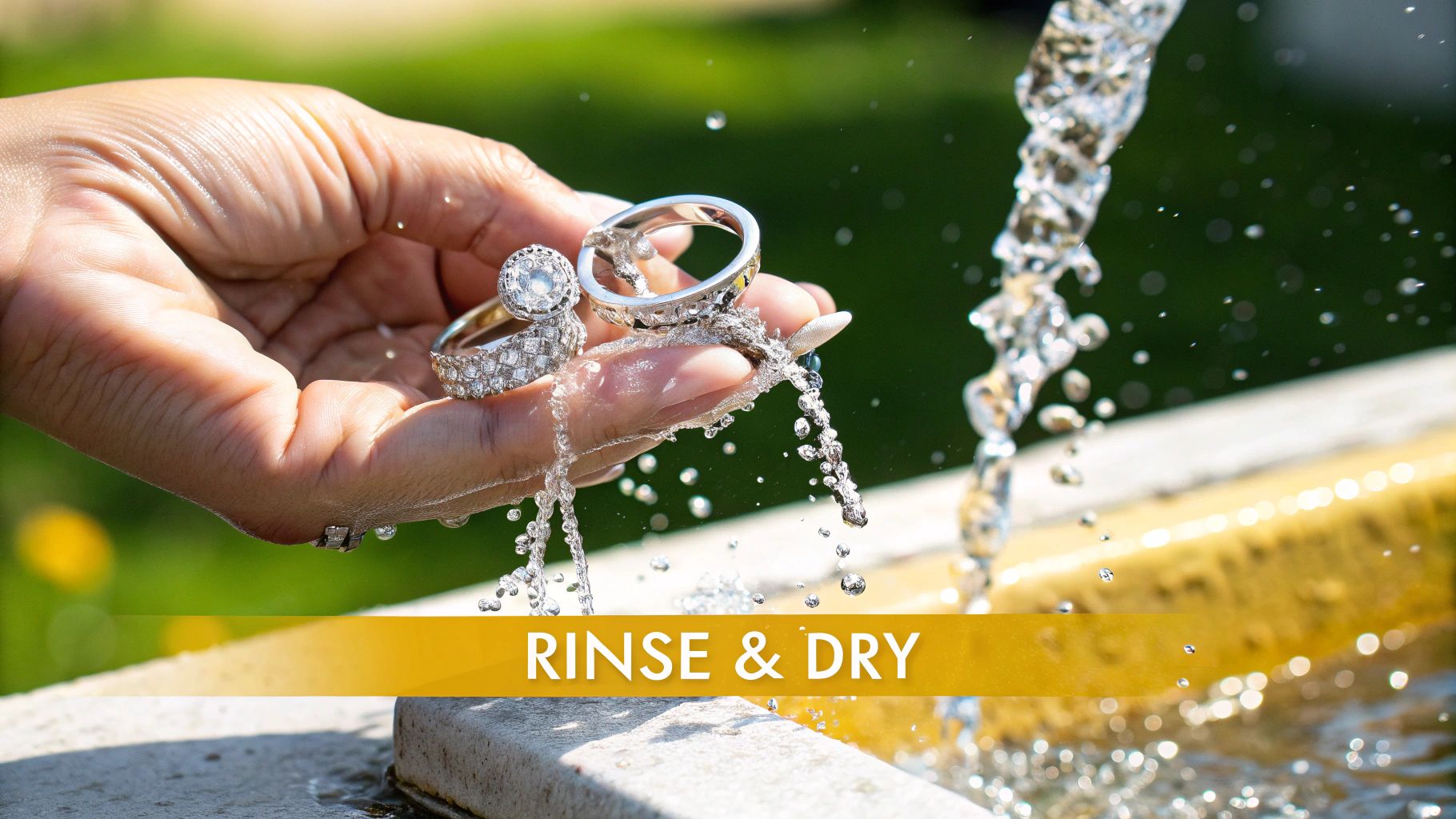
Even with the best cleaning methods in your toolkit, you're bound to have questions. Knowing the little details—the dos and don'ts—is what keeps your favorite pieces looking brand new for years to come.
So, let's tackle some of the most common questions about keeping sterling silver safe and sparkling.
Is It Safe to Use Toothpaste to Clean My Silver?
This is a persistent myth that makes jewelers cringe every time they hear it. The answer is an emphatic no. Please, don't do it.
Most toothpastes contain mild abrasives like silica, which are fantastic for scrubbing plaque off your teeth but disastrous for soft metals. These tiny particles will create thousands of micro-scratches on your silver's surface, permanently dulling its beautiful finish. It might look like it’s working at first because it removes tarnish, but you're actually causing irreversible damage by scratching the metal itself.
Stick to non-abrasive methods, like a proper polishing cloth or the gentle baking soda and foil bath we covered earlier. Your jewelry will thank you.
How Do I Clean Silver Jewelry with Gemstones?
When gemstones are involved, you have to be extra careful. The right approach depends entirely on the type of stone set in your silver.
-
Porous Gems: Never, ever submerge pieces with soft, porous stones like pearls, opals, turquoise, or coral in any cleaning liquid, including DIY solutions. The chemicals can easily cause discoloration or even start to dissolve the stone. Instead, use a silver polishing cloth to carefully clean the metal, making sure to avoid the gem itself.
-
Hard Gems: For jewelry with hard, durable stones—think diamonds, sapphires, or rubies—you can typically use a mild soap and water solution. A very soft-bristled brush (a baby toothbrush is perfect) can help you gently clean around the settings, but never scrub aggressively. You don't want to risk loosening the prongs.
It's always safest to avoid commercial chemical dips when gemstones are part of the piece. The harsh formulas can damage delicate stones, dissolve adhesives used in some settings, or leave a cloudy residue that's impossible to remove.
Why Does My Silver Tarnish So Fast?
If you feel like you're constantly fighting tarnish, take a look at your environment and habits. The speed at which sterling silver tarnishes is directly linked to the air around it and what it comes into contact with.
The main culprit is the chemical reaction between silver and airborne sulfur. High humidity is a huge accelerator, which is why a steamy bathroom is one of the absolute worst places to store your jewelry. Air pollution and direct contact with substances like lotions, perfumes, and hairspray also speed things up dramatically.
Leaving your jewelry out in the open is a surefire way to watch it tarnish quickly. Storing it in a protective, airtight container makes all the difference. The durability of your pieces over time is a common concern, and you can explore more about how long sterling silver rings last in our detailed guide.
Can I Wear Sterling Silver in the Shower or Pool?
It's always best to take your silver jewelry off before you hop in the shower or go for a swim. While a little plain water isn't the end of the world, the chemicals mixed in with it are the real problem. Tap water often contains minerals that can leave a dull film, while soaps and shampoos build up in detailed crevices.
A swimming pool, however, is a definite no-go. The chlorine used to treat pool water is incredibly harsh and will cause severe, rapid corrosion and blackening on sterling silver. The same rule applies to hot tubs, which have similar chemicals, and even the ocean—saltwater is also highly corrosive. Taking your jewelry off is a simple habit that will save you a lot of cleaning effort later.
At Precious Pulse Jewelry, we believe beautiful accessories should be accessible and easy to care for. Explore our stunning collection of 925 sterling silver pieces and find your next favorite today. Visit us at https://preciouspulsejewelry.com to discover affordable elegance.

